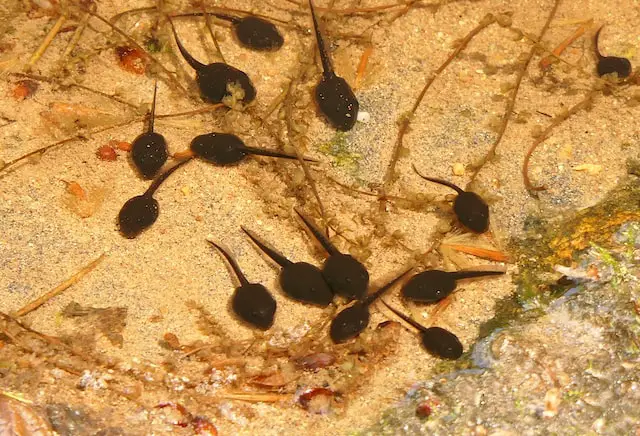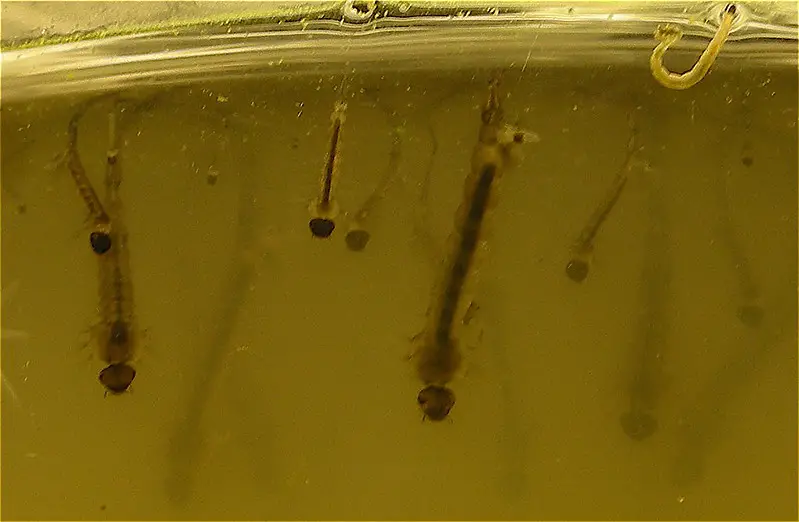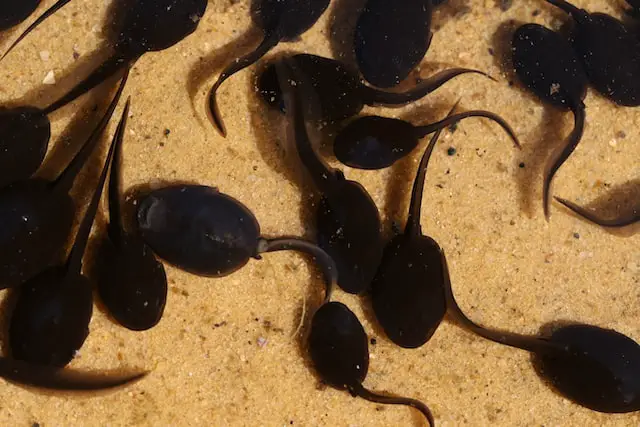Tadpoles are the larvae of frogs and toads and undergo a metamorphosis process that transforms them into adult frogs or toads. Mosquito larvae are found in stagnant water and undergo a metamorphosis process that transforms them into adult mosquitoes. Tadpoles have a smooth back, gills for breathing underwater, and a tail for swimming and eventually grow into frogs while mosquito larvae lack these features and develop into adult mosquitoes after going through several stages of metamorphosis.
What are tadpoles?
Tadpoles are the aquatic larvae of frogs and toads. They have long tails and lack developed legs. Most tadpoles are herbivorous, feeding on algae and other plants. As they mature, they metamorphose into adults with four legs and lose their tails.
The Physical Appearance of Tadpoles
(Photo by Patti Black on Unsplash )

Tadpoles are the larvae of frogs and toads and are often characterized by their long tails and small, undeveloped legs. They have a smooth, streamlined body that is adapted for swimming, and their tails are used for propulsion. Tadpoles are usually herbivores and feed on algae, aquatic plants, and other organic matter. They can grow to be several centimeters long and can vary in color, depending on the species of frog or toad they come from.
What are mosquito larvae?
Mosquito larvae are the immature form of mosquitoes. They hatch from eggs laid by female mosquitoes and go through several stages of development before becoming adults. Most species of mosquito larvae live in water, where they feed on microscopic organisms. Some species can survive in dry conditions for long periods of time without food or water.
The Physical Appearance of Mosquito Larvae
(Photo By Enrique Dans on Flickr)

Mosquito larvae, on the other hand, are elongated and have a slightly curved body. They do not have legs and instead use their mouthparts to crawl through the water. Mosquito larvae feed on small aquatic creatures, such as tiny insects, and organic matter. They are usually less than a centimeter long and are gray or brown in color.
How do tadpoles and mosquito larvae differ?
Tadpoles and mosquito larvae differ in several key ways. For one, tadpoles are typically larger than mosquito larvae. Additionally, tadpoles have tails while mosquito larvae do not. Finally, tadpoles breathe through gills whereas mosquito larvae breathe through spiracles.
How are tadpoles and larvae similar?
Tadpoles and mosquito larvae are both aquatic, meaning they live in water. They breathe using external gills and have a tail that helps them swim. Tadpoles eventually develop into frogs or toads, while mosquito larvae develop into adult mosquitoes.
How do you identify larvae?
To identify mosquito larvae, look for small, dark-colored insects with a slender body and long legs. They are often found near water sources, such as ponds or lakes. To confirm that an insect is a mosquito larva, observe its movement. Larvae typically swim in a swimming motion known as a “wiggle.”
How do you identify Tadpoles?
Tadpoles are usually larger and have tails, while mosquito larvae lack tails. In addition, tadpoles typically have gills for respiration, while mosquito larvae do not. Finally, the two groups can often be distinguished by their swimming patterns, with tadpoles moving in a side-to-side motion and mosquito larvae moving up and down.
Different Habitats of Tadpoles and Mosquito Larvae
Tadpoles are found in a variety of water bodies, including ponds, lakes, and streams. They prefer shallow, still waters with plenty of vegetation, as this provides them with a source of food and protection from predators. Mosquito larvae, on the other hand, are typically found in stagnant water, such as puddles, ditches, and old tires. They do not need a lot of vegetation to survive and can live in a variety of different habitats.
How can you tell mosquito larvae?
To the untrained eye, mosquito larvae and tadpoles may appear to be very similar. Both are aquatic creatures with long, slender bodies and tail-like structures. However, there are several key differences that can help you tell them apart.
For one, mosquito larvae do not have gills like tadpoles do. Instead, they breathe through a small tube at the end of their abdomen. Tadpoles also tend to be bigger than mosquito larvae; while adult mosquitoes typically only grow to be about 1/4 inch long, tadpoles can reach lengths of up to 6 inches!
Another key difference is in the way that the two types of larvae move. Mosquito larvae use a wiggling motion to propel themselves through the water, while tadpoles use their tails to swim in a more traditional way.
Finally, you can usually tell mosquito larvae and tadpoles apart by their diet. Mosquito larvae are mostly carnivorous, feeding on small insects and other invertebrates. Tadpoles, on the other hand, are mostly herbivorous; they feed on algae and plants.
Do mosquitoes lay eggs or larvae?
It is a common misconception that mosquitoes lay their eggs in water. In fact, they actually lay their eggs on the surface of the water. The larvae hatch from the eggs and then sink to the bottom of the water body, where they develop into adults.
What kills mosquito larvae?
There are many things that can kill mosquito larvae, including predators, parasites, and disease. Some of the most common predators of mosquito larvae are fish, amphibians, and insects. These predators can either eat the larvae or lay their eggs in the water where the larvae live, which will then hatch and eat the mosquito larvae. Parasites can also kill mosquito larvae by infecting them with a virus or bacteria. Finally, disease can kill mosquito larvae by causing them to succumb to an infection.
How to kill/Get rid of mosquito larvae?
- Remove standing water: Mosquito larvae need standing water to breed and survive, so removing standing water sources such as buckets, pots, tires, birdbaths, and other containers can help control their populations.
- Use larvicides: Chemical products such as Bacillus thuringiensis israelensis (BTI) and methoprene are effective at killing mosquito larvae. These products can be found in granular or liquid form and can be added to standing water sources.
- Use natural predators: Mosquito larvae can be controlled by natural predators such as dragonflies, birds, and fish. Adding fish to ponds or water gardens can help control the mosquito larvae population.
- Drain or fill in standing water: If you cannot remove standing water, you can drain it or fill it in with soil or sand to eliminate the habitat where mosquito larvae live and breed.
What happens if you touch mosquito larvae?
If you touch mosquito larvae, they may stick to your skin and clothes. If you have an allergic reaction to them, you may develop a rash or other symptoms.
What is the life cycle of a tadpole?
Tadpoles undergo a metamorphosis process that transforms them into adult frogs or toads. During this process, their tails shrink and their legs and other organs begin to develop. Once they have transformed, they leave the water and live on land as adult frogs or toads. The entire process can take anywhere from several weeks to several months, depending on the species of frog or toad.
The life cycle of a tadpole typically involves four stages:
- Egg: The life cycle starts with a female frog laying eggs in water, which hatch into tadpoles after a few days.
- Tadpole: The tadpole stage is the larval stage, during which the tadpole feeds on algae and other small aquatic organisms. Over time, the tadpole grows and develops legs, a tail, and other structures.
- Transformation: As the tadpole matures, it undergoes a transformation, or metamorphosis, into a juvenile frog. During this stage, the tadpole’s tail is absorbed, its legs and lungs develop, and its mouth changes shape to better accommodate a diet of insects and other small prey.
- Juvenile frog: Once the transformation is complete, the tadpole emerges from the water as a juvenile frog and begins its life as an adult. The juvenile frog will continue to grow and mature into an adult frog over several months or years, depending on the species.
What do tadpoles eat?
Tadpoles are omnivorous and consume a variety of plant and animal matter. Their diet includes algae, aquatic plants, insects, and other small invertebrates. As they grow older and develop into frogs, their diet shifts and they begin to eat more insects.
Do tadpoles need oxygen?
Yes, tadpoles need oxygen to survive. They breathe through their gills and absorb oxygen from the water around them. If the water is too polluted or doesn’t have enough oxygen, the tadpoles will die.
What is the life cycle of a mosquito larvae?
Mosquito larvae also undergo a metamorphosis process, but it is different from that of tadpoles. After a few days, the larvae transform into pupae, which then transform into adult mosquitoes. The entire process can take anywhere from a few days to a couple of weeks, depending on the species of mosquito.
Mosquito larvae go through four distinct stages in their life cycle: egg, larva, pupa, and adult. The time it takes to complete the cycle varies depending on the species of mosquito, but is generally between two weeks and one month.
- Egg: Female mosquitoes lay their eggs in water, where they will hatch into larvae in about 48 hours.
- Larvae: Larvae go through four instars, or growth stages. They feed on microscopic organisms in the water and grow rapidly.
- Pupae: Pupae are a transitional stage between larvae and adults. They do not eat, but remain develop inside their protective casing.
- Adult: Adults emerge from the pupal stage ready to mate and start the cycle anew.
What is the difference between larvae and larval?
Larvae and larval are two different stages in the life cycle of a mosquito. The difference between the two is that larvae is the stage where the mosquito is developing inside the water, while larval is the stage where the mosquito is outside of the water and beginning to develop into an adult.
What are the benefits of tadpoles?
Tadpoles play an important role in the ecosystem and provide several benefits, including:
- Aquatic ecosystem health: Tadpoles feed on algae and other small aquatic organisms, helping to control the growth of these organisms and maintain the balance of the aquatic ecosystem.
- Food source: Tadpoles serve as a food source for many aquatic animals, including fish, frogs, and birds, which helps to support their populations.
- Biodiversity: Tadpoles are a crucial part of the amphibian life cycle and help to maintain biodiversity by ensuring the survival of amphibian species.
- Bioremediation: Tadpoles are capable of breaking down and removing pollutants from the water, making them valuable for cleaning up contaminated water bodies.
- Ecotourism: In some regions, tadpoles and other amphibians are important tourist attractions, drawing people to visit wetlands and other natural areas for observation and education.
Overall, tadpoles play a key role in the health and stability of aquatic ecosystems and contribute to the overall biodiversity of the planet.
What are the dangers of mosquito larvae?
Mosquito larvae can pose several dangers to both human health and the environment:
- Disease transmission: Mosquitoes are vectors of many serious diseases, including malaria, dengue, yellow fever, and Zika virus. Mosquito larvae can become infected with these diseases if they feed on infected hosts, and the adult mosquitoes that emerge can then transmit these diseases to humans and other animals.
- Public health: Mosquito bites can cause itching, swelling, and redness, and can also transmit diseases to humans. In addition, the presence of large numbers of mosquitoes can make it difficult to enjoy outdoor activities, leading to a reduced quality of life.
- Environmental damage: Mosquitoes can negatively impact the environment by reducing the populations of amphibians, birds, and other animals that serve as hosts for their larvae. They can also cause damage to crops and other vegetation by feeding on the sap of plants.
- Economic impact: The presence of large numbers of mosquitoes can lead to decreased tourism and recreation in affected areas, as well as increased costs for disease control and management.
Overall, it is important to control and reduce the populations of mosquito larvae to minimize the dangers they pose to human health and the environment.
Featured Image By – Photo by James Wainscoat on Unsplash









